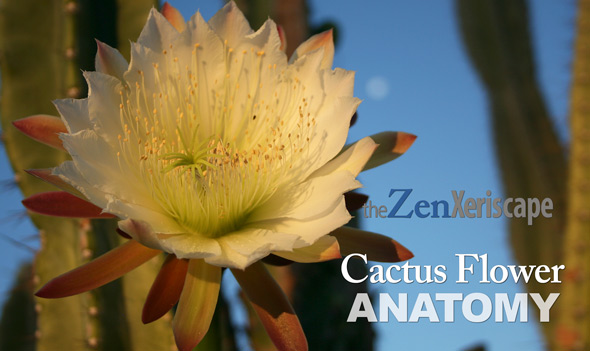Ten years ago, I bought an eight-inch organ pipe cactus (Stenocereus thurberi). Today, it is over 10-feet tall and has multiple arms. Since then, I have bought more eight-inchers, and made multiple cuttings. This cactus seems like a perfect fit for my xeriscape, but is it right for you? Read about the organ pipe cactus pros and cons, and decide for yourself!
Organ Pipe Cactus description
But, before we discuss the pros and cons, I’ll describe the organ pipe cactus. It grows naturally in southwestern Arizona. In that location, the Organ Pipe Cactus National Monument (part of the US National Park Service) features large stands of these beauties.
They can reach 25 feet tall at maturity, while usually staying smaller in a suburban landscape. In addition, this cactus continually grows arms out of the side of the plant. Over the years, it’s width can easily reach 12 feet or more as those arms continue to develop.
This cactus also produces white flowers and fruit, which is deliciously sweet. Sharp spines protect the fruit, but they are easy to remove (be sure to wear gloves). In addition, the small seeds are edible and filled with protein.

It grows naturally in southwestern Arizona.
Photo by Doug Martin
Organ Pipe Cactus pros and cons
PROS
Visual charm:
This cactus just looks good! The organ pipe cactus adds a dramatic southwestern flair to any arid landscape. It’s a columnar cactus with tall, columnar stems that can serve both as a focal point or as a striking background plant.
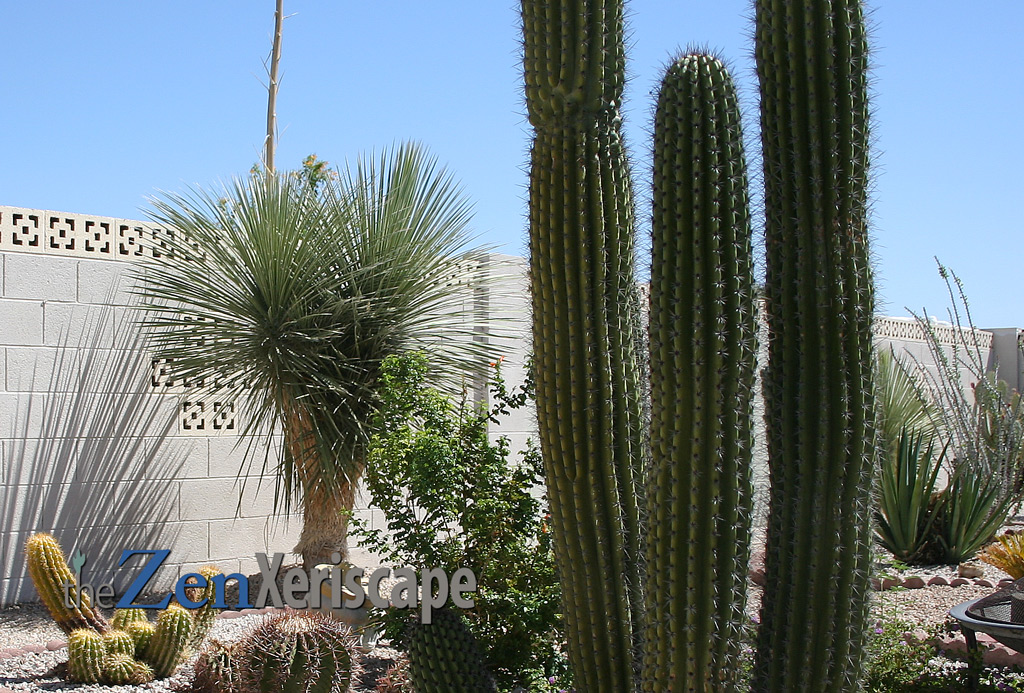
to the right and the soaptree yucca on the left.
Photo by Doug Martin
Garden clearance deals! Wow! (As an Amazon Associate, I earn a commission from qualifying purchases.)
Low maintenance:
Other than supplemental waterings to spur growth, there is absolutely nothing to do to maintain this hardy cactus. My organ pipe cactus has flowered and produced fruit, which is edible. But, you don’t have to harvest the fruit if you don’t want to.
Drought tolerant:
While I do give this cactus supplemental water during the summer, I don’t think I would have to. It is adapted to the arid desert environment that is prevalent in southern Arizona.
During the summer, I water mine once-a-week, being sure to keep all water away from the base of the plant. During the winter, once-a-month is fine.
Tolerates high and low temperatures:
The organ pipe cactus grows naturally in the Sonoran Desert in southwestern Arizona, so it’s acclimated to extremely high desert temperatures.
Despite that, it does show a little stress while enduring 120 degree fahrenheit temps. My organ pipe gets a little yellow on the west sides of its columns during the hottest summers.
It is best adapted to USDA hardiness zones of 9-to-11. However, depending on your locale, it might need some protection if temperatures dip below 20 degrees during the winter.
During the winter, I have never protected my organ pipe cactus, and I probably never will. Maybe, though, if winter temps were projected to dip into the teens, I might put styrofoam cups on the top ends for protection.
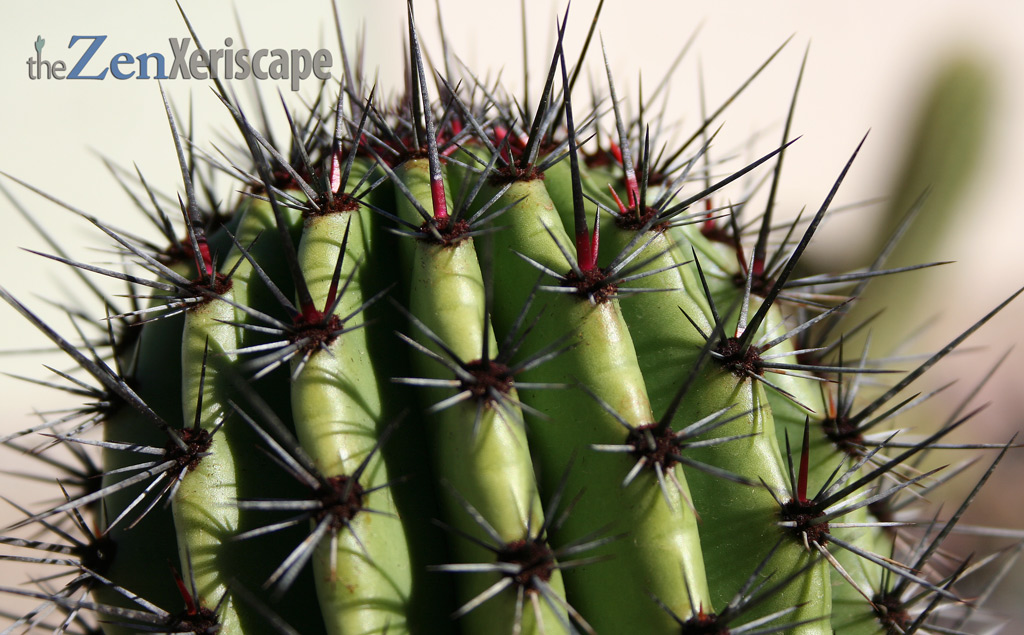
The new growth at the top of each column
can be protected from cold temps by placing
a styrofoam cup on top.
Photo by Doug Martin
Versatile uses in your xeriscape:
In addition to growing this dramtic cactus in your landscape, you can also grow it in a container. The advantage of growing it in a container is that it will stay well-contained in whatever planter size you choose.
I bought my organ pipe cactus when it was eight-inches tall. It grew fast, but I gave it supplemental water. By withholding water, it would hardly grow at all, but still remain healthy and vibrant.
Fast growing (with extra water):
If you don’t provide the organ pipe cactus with any supplemental water, it will be a slow-grower. However, if you do give it extra irrigation, it will grow quickly.
For example, I bought a few eight-inchers ten years ago. I planted them in soil that drained quickly, but I gave them supplmental water every week.
From then on, this cactus added eight inches almost every year. So, in a little more than two years, it doubled in size.
Today, it still grows quickly. In addition, my organ pipe cactus has added multiple arms. They started growing after the fourth year.
I know all this sounds divergent from what you might have read on the internet, but I’m only relaying my own experiences that took place in my landscape. And in my experience, this cactus is a fast-grower!
Slow growing (with no supplemental water):
Yes, this cactus can also grow extremely slow if you do not provide supplemental water. That can be a benefit, too, especially if you’re growing it in a container or a smaller landscape.
Plus, the slow-growing aspect means less maintenance and less water expense! Those are all good things, especially in our era of depleting ground water resources in Arizona and throughout the populated world.
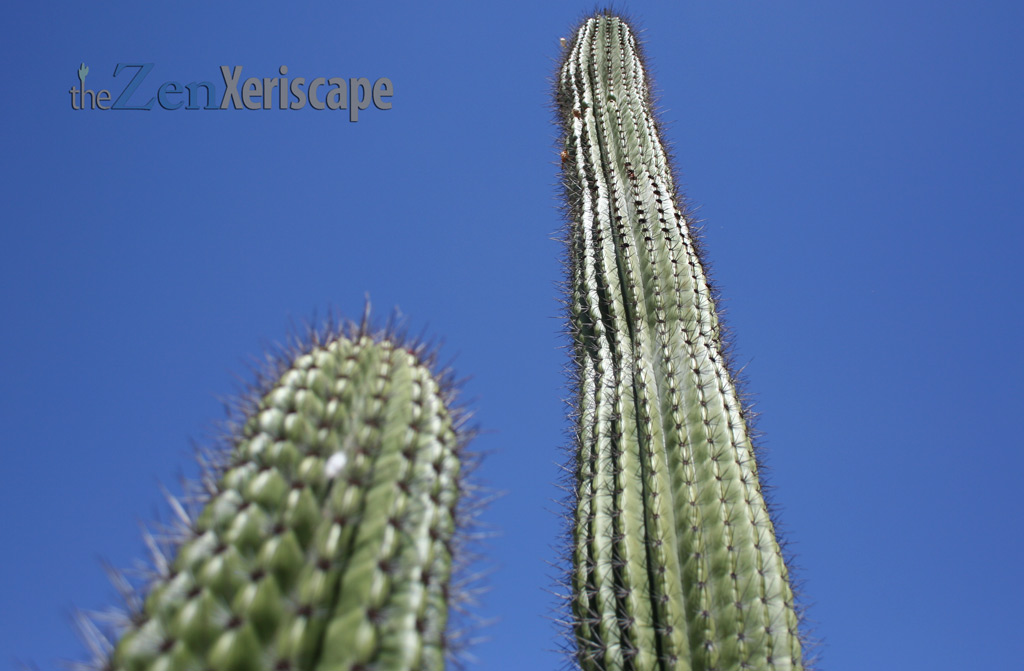
that can get very tall. My specimen is growing
very fast, but I give it supplemental water.
Photo by Doug Martin
Get Prime! (As an Amazon Associate, I earn a commission from qualifying purchases.)
Organ Pipe Cactus pros and cons
CONS
Slow growth:
Without supplemental water, the organ pipe cactus can grow slowly. That’s a detriment, especially if you prefer instant gratification in your landscape.
However, slow growth can also be a plus, as I’ve already discussed. If your cactus is going in a planter, it can thrive without much water and still stay the same size. So, you won’t have to continually update its planter size as it grows.
And, you can pick a plant size that fits your living space, and be confident that it will provide years of southwestern charm with minimal maintenance.
Please be aware, though, that my experience has shown that the organ pipe cactus can grow extremely fast, especially with supplemental water.
Transplant shock:
Just like many plants, the organ pipe cactus can experience transplant shock. That trauma can be exhibited by yellowing of the flesh, or slower growth.
During its recovery time, do not overwater, and do not let water pool near its base. Above all, plant this cactus in soil that drains well, to avoid root or column rotting.
However, once this cactus develops a well-established root system, it will become a vigorous plant in your home or landscape.
Can rot with too much water:
This succulent grows naturally on the hillsides of the Sonoran Desert. There, soil drains well and it doesn’t rain much. So rain never pools around the plant, and when monsoon rains do drench the landscape, it drains away quickly.
So, to prevent root rot, we should plant the organ pipe cactus in well-draining soil. Even better, plant it in an elevated location, like a multi-level rock garden.
Sensitive to cold temperatures:
While this cactus can thrive in extremely warm temperatures, it is sensitive to colder winter temps. If temperatures in your location dip into the lower 20s F or less, provide protection.
To protect the newest growth from freeze damage, place styrofoam cups on the the tips of the columns. In addition, you can wrap your organ palm cactus in a frost blanket.
Here in my landscape in the Phoenix, Arizona suburbs, I have never protected this cactus from cold weather. But, it has briefly gotten into the low 20s on cold winter nights. I guess that shows how tough this adaptable cactus can be!
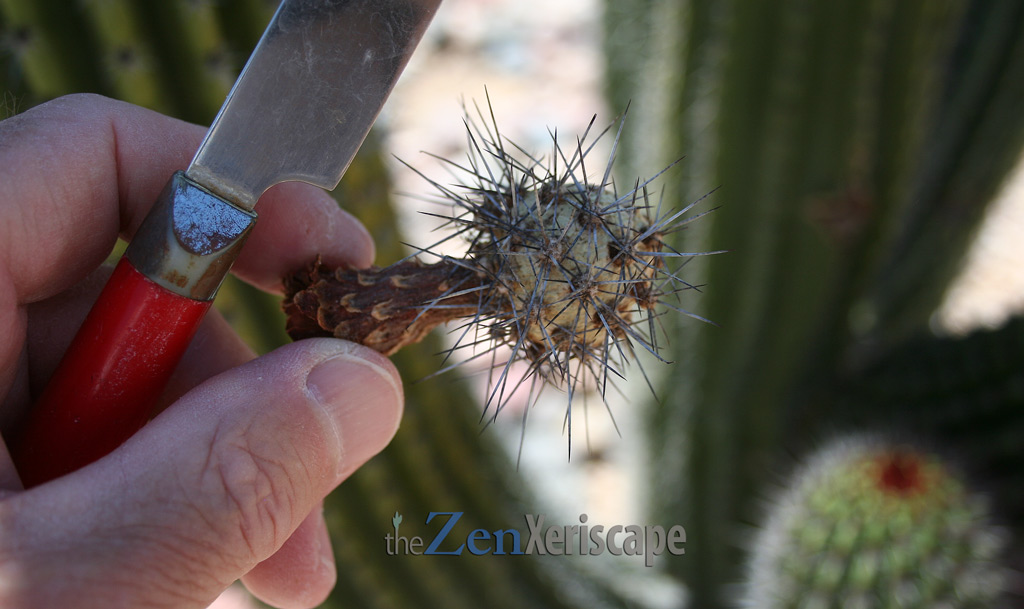
is covered with protective, sharp spines.
They are easy to remove while wearing gloves.
Photo by Doug Martin

From these tiny seeds, we can eventually grow
the giant organ pipe cactus.
Amazing!
Photo by Doug Martin
TAKEAWAYS
Organ Pipe Cactus pros and cons
If you live in the southwestern United States or other arid environments throughout the world, you would enjoy the organ pipe cactus in your landscape.
It’s hardy, it is drought-tolerant, it is heat-tolerant, and can grow quickly with supplemental water. In addition, this cactus has white flowers in the spring that then produce deliciously sweet fruit.
And, if you don’t live in arid regions, you can still grow this spectacular cactus in your home or apartment. Just put it in a planter, and enjoy years of maintenance-free southwestern charm.
Content and photos by Doug Martin and The Zen Xeriscape


